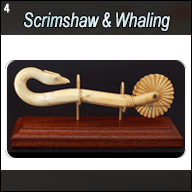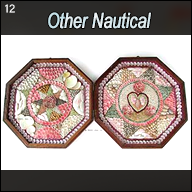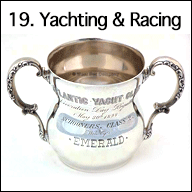14. Furniture
Prices in U.S. Dollars are in GREEN
 |
14.38 LAP DESK. Absolutely extraordinary, early 1800’s nobleman’s portable traveling desk of the most superb quality! This magnificent creation is made of solid rosewood with meticulously-inlaid brasswork that defies the imagination! The writing box is fully brass bound on all sides with recurring “tree and fiddle” motifs decorating the top and front. These surfaces also bear elaborate inlaid brass escutcheons. Opening the stout hinged upper section reveals the interior with the most exquisite presentation. The leather writing slope is bordered with tooled gold in an ornate floral pattern. Complimenting the tooling, inlaid brass strips and brass “wagon wheels” are inlaid into the wooden surround. A sunburst key escutcheon covers the functional skeleton key lock which secures entry to the lower trays. The original silk ribbon pulls provide access. Opening the lower writing slope reveals three trays separated by two slats. At first look (to a potential thief) the slats appear permanently affixed. But in fact they are spring-loaded, and removing them allows another spring-loaded cover to be released, revealing three “secret” drawers within. Incredibly, each of the small drawers (5 inches wide, 2 inches deep and ¾ inches thick) is inlaid with brass stringing on their rich rosewood fronts with turned ebony drawer pulls! On the side of this desk is another large drawer with inset brass handle which serves to open the drawer as well as to lift the chest by means of a matching handle on the opposite end. Cleverly, this drawer is locked into position by a spring-loaded pin which is held in position when the upper lid of the box is closed. Attesting to its early age, this remarkable traveling set is equipped with two gilt brass candle holders which fit into inlaid brass receptacles on the front edge. The upper lid is also lined with elastic red velvet lines to hold papers and envelopes. The front tray is remarkable in that it contains an inkwell, sand shaker, two lidded compartments and a pencil tray inlaid with ivory. The brass inkwell has a button-operated cap and the sand shaker appears to be of unmarked silver. In the interest of brevity, there are even more features we have chosen not to describe here. This most impressive presentation was undoubtedly commissioned of a very wealthy English nobleman, circa 1830. Now, beautifully preserved, it is a rare relic from the very upper class of the pre-Victorian era. 18 inches wide by 11 ¾ inches across and 8 inches high. The original green cloth covering still adorns the bottom. The condition of this marvelous piece must be rated as excellent in all respects. To be sure there are signs of wear and use. This chest/writing desk is totally complete noting the bases of the candle sticks are no longer present. Otherwise it rates as one of the nicest ever made! |
 |
 |
| perspective | inner lid |
 |
 |
| interior | interior detail |
 |
 |
| trays | secret drawers |
 |
14.46 CHINA TRADE LAP DESK. Impressive mid-19th century or earlier traveler’s roll top desk of early Chinese export manufacture. This extra large example of such a desk is constructed entirely of rich hand-fashioned camphorwood. The professional workmanship exhibited in its construction is nothing short of remarkable! All joints are dove-tailed. The brass fittings are tight and snug within their wood surrounds. Pulling on the brass handle inset in the front not only opens the bottom drawer but pulls back the upper roll top desk. It reveals a tray of 5 compartments when lifted, locks into an elevated position held by ingenious spring-loaded wooden slats on each side. It contains 6 pigeon holes and a central locking cupboard. Lifting the slant front opens the sloped writing surface with its original green felt covering. It is outlined in solid ebony wood trim. At the top are 4 more compartments, a long pencil tray and a semi-secret concaved tray for holding pens. Pressing one end of the tray opens the space under it. A small leather pull at the top of the slope opens yet another compartment which hides a panel covering secret compartments. Using a thin needle inserted into a tiny hole in the far right compartment, a spring-loaded trigger releases the panel to uncover 3 small drawers with leather pulls. Each drawer is beautifully hand-dovetailed. The front and sides of this desk are constructed of rich, aromatic camphor wood bearing fine decorative string inlays of ebony wood. The top front bears a large inlaid brass cartouche and the sides have inset flush folding brass handles. The exposed corners of this desk are covered in decorative/protective thick brass edging on all sides. 21 inches wide by 11 inches high and 17 inches deep when closed. Excellent original condition in all respects, considering this is a working piece of traveling furniture over 160 years old! Literature: Carl Crossman, “The Decorative Arts of the China Trade,” 1991, The Antique Collectors Club, Suffolk, England. Page 248, Colour Plate 96. Roll-top desk, Asian hardwoods with brass hardware. Circa 1830. 24 3/8 x 20 ¼ x 6 ¼. |
 |
 |
| perspective | open perspective |
 |
 |
| partially open | front |
 |
 |
| side | back |
 |
 |
| interior | hidden panel |
 |
 |
| secret drawers | lock |

|
14.43 TRAVELER’s DESK. Exquisite mid-19th century Anglo-Indian lap desk made entirely of solid ebony with secondary camphor wood (bottom and drawer sides) and stout brass furniture (hinges, hooks, lock and corners). When opened the interior reveals a startlingly beautiful array of inlaid ivory discs, so numerous as to defy numbering! The discs line the entire periphery of the two-part folding writing slope covered in rich black leather. Each part of the slope hinges open to compartments within. The slope in the lid is held in place by a comma-shaped brass lever. The upper slope opens to an inlaid ivory cover which slides up and out revealing three hidden drawers with silk pulls. The drawers exhibit the finest craftsmanship with incised ebony facings and dovetailed construction. Each drawer measures 4 7/8 inches wide, 3 inches deep and 1 inch thick. The upper compartment of the desk has a wave-like ebony panel with inlaid ivory discs arranged in an artful sinuous array. Behind it are three shallow trays. Above these are four compartments, two of which hold covers for an inkwell and sand shaker. The largest compartment, in the middle, holds a concave pencil tray which flips up when pressed on the right end exposing yet another secret compartment! Covering all of this is a meticulously-inlaid hinged ebony lid with lock. When closed, two small brass hooks secure it in place allowing the lock to engage the front slope, securing the entire desk. Perhaps the most stunning aspect of this offering is its incredible fluted exterior carved with precise recurring striations. 16 ½ inches wide by 9 ½ inches deep and 5 ¼ inches thick. The writing slope measures 16 ½ by 11 ½ inches. Condition is nothing short of spectacular. All functions operate properly and there is no damage whatsoever. Complete with original functional skeleton key. Brilliant! Well over 150 years old! |
perpective |
closed |
secret interior |

|
detail |
back |
14.35 BATTLESHIP FURNITURE. A really amazing furniture find. Our best in 35 years! Genuine officer’s stateroom chest of drawers as outfitted on the famous early American dreadnaught, battleship U.S.S. SOUTH CAROLINA (BB-26). This rare surviving example of authentic ship’s furniture is made of solid quarter sawn oak with poplar, pine and cedar secondary woods. The construction was expertly hand-made with hidden dove-tail joints, chamfered edges and solid brass fittings throughout including all 4 matching lever locks with 2 working skeleton keys. The lovely side panels are inset in the traditional manner. This classic “stacking” campaign chest is in two parts centered on two dowels between. The upper stack houses a large single cupboard with one removable shelf. The left door locks in place with a heavy brass cane bolt. The right door closes with a positive button latch and can be locked closed with the key. On the back, construction is of vertical tongue and grove cedar. The upper right hand corner is marked “9501 Fitted Aug 4th /01”. In orange grease pencil, “#2 L S. Carolina.” Then in black paint, “U.S.S. So. Carolina Ward Officers Stateroom “L”. The bottom section is also painted, “U.S.S. So. Carolina K.K. Ward Officers Stateroom “B.” There are holes in all 4 back corners where this furniture was originally secured to the ship’s bulkhead. All drawers move freely and lock closed properly. The two cabinet doors open and close smoothly with a positive fit. This handsome chest of drawers measures 51 ¾ inches high by 21 inches deep overall and is 42 inches wide. Overall condition is excellent and very sturdy. As expected this piece of genuine U.S. Navy shipboard furniture 110 years old has undergone some minor modifications as evidenced by plugged screw holes here and there. Importantly there are no cracks, splits, chips, warpage or dents. A genuine, very rare surviving relic of functional and identified shipboard furniture from America’s first dreadnought! Request Price The battleship SOUTH CAROLINA (BB-26) was laid down on December 18, 1906 at the William Cramp & Sons Shipyard in Philadelphia, Pennsylvania. She was launched July 11, 1908 and commissioned on March 1st 1910. The ship had a length of 453 feet, a beam of 80 feet and a draft of 24 ½ feet, with a displacement of 16,000 tons. Impressively armored and gunned, the ship carried 8-12 inch guns and 22-3 inch guns, with 8-10 inches of armor in crucial areas. Her compliment was 751 officers and men. The SOUTH CAROLINA was the first of her class -- the first American dreadnought -- all-big gun battleship. Soon after her commissioning the battleship made voyages to Europe in late 1910 and in 1911. During 1913-14, SOUTH CAROLINA was intimately involved in the U.S interventions in Haiti and Mexico. During the First World War SOUTH CAROLINA deployed in the Western Hemisphere. In September 1918 she escorted a troop convoy across the submarine-infested Atlantic. Following the end of World War I, she served as a troop ship, bringing over 4,000 servicemen in four voyages from France to the United States in the period February-July 1919. In June-August 1920, SOUTH CAROLINA carried Naval Academy midshipmen on a training cruise to the Pacific, visiting ports on the U.S. west coast and Hawaii before returning to the east coast by way of the Panama Canal. She made another midshipmen's training cruise to European waters in mid-1921. USS SOUTH CAROLINA was decommissioned at Philadelphia, Pennsylvania, in December 1921. She was stricken from the Navy list in November 1923 and was scrapped in accordance with the Washington naval limitations treaty. Interestingly this chest-of-drawers found its way West and was used for a number of years in the lobby of the famous, historic old Smith River Hotel. Smith River is the most northerly town on the California coast. |
FRONT |
OPEN |
SIDE |
TOP DETAIL |
DOVETAIL |
HIDDEN DOVETAIL |
BACK |
DATE |
MARKINGS |
SHIP |
14.32 WALL MIRROR. Splendid, second half of the 19th century American wall mirror containing a broadside portrait of the USS VANDALIA as painted by listed artist James Scott Maxwell. This very handsome presentation consists of a carved walnut frame with columns carved in the form of rope twists. The top of each column is finished with decorative beading. They support the overhanging cover which is inset with 11 "tear drop" finials and a scalloped border. The remainder of the frame has repetitively beaded panels matching the columns. The large mirror in the bottom reflects its age with its old wavy glass construction.The crowning touch of this presentation is the fine watercolor entitled "United States Corvette "Vandalia". 8 Guns. 2000 Tons 1874." At the bottom and is signed lower left "JSM 1878". This port broadside view shows the staunch vessel at anchor with commissioning pennant streaming from the main mast and the American ensign flying aft. Several crewmen are depicted on deck along with rigging details and deck fittings. The painting measures 9 1/4 inches by 6 inches sight. The entire presentation measures just short of 32 inches high by 16 1/2 inches wide at the top. Condition is "excellent" in every respect. The painting, under old wavy glass, is perfectly preserved. The wooden frame is in its original old finish with a nice dry surface, just the way furniture collectors like them! The back of the mirror still retains its original brass hanging bracket at the top and is covered with old protective wooden panels with exhibit good oxidation. .Request Price
The 8 gun screw sloop of war VANDALIA was laid down at the Boston Navy Yard in 1872 and commissioned on January 10, 1876. Soon after commissioning VANDALIA deployed to the Mediterranean where she spent the next 3 years with the European Squadron. It was during her European deployment that this painting by British artist Maxwell was rendered. In April 1879 she transferred back to the U.S. and the North Atlantic Squadron. She was home ported in Norfolk, Virginia for the next 5 years. It is likely that this mirror was manufactured during that time frame.
In October 1884 VANDALIA underwent extensive repairs at the Portsmouth Naval Yard, New Hampshire. Recommissioned on February 15, 1886 she deployed for the West Coast as the flagship of the Pacific Squadron. The next two years saw her operating in Hawaiian and Samoan waters as well as along the coasts of North and South America.
In October 1888, while undergoing repairs at the Mare Island Navy Yard, California, VANDALIA was again called to duty in Samoa due to increasing tensions between American and German interests there. While anchored in the harbor of Apia, Samoa on March 16, 1889 the American fleet was beset by typhoon force winds and mountainous seas. VANDALIA and her sister ship TRENTON sank despite heroic efforts of their crews. American casualties totaled 49 killed, 43 from VANDALIA alone. After the disaster the ships were declared a total loss and their scrap was donated to the Samoans.
19th century British painter, James Scott Maxwell's work covered a narrow subject range of warships and British scenery. His paintings carried the signs of immense brilliance such as in "Villefranche 188," a drawing of a fleet of ships. Most of his paintings were small watercolors or the modest sketches of steamers, like "Clyde," "Duchess of York," and "Ben Lomond," all carried out in small, 7 by 9 inch frames or slightly larger.
His repertoire concentrated on seascapes of pre-World War I British seagoing steamers and men-o-war. The works embody a form of art known popularly as "British or Continental watercolors." The type was more or less a technical 'photo realistic' drawing, aimed at factual representation, rather than artistic creativity. Maxwell's drawings of American steamships, such as "St. Paul" and "Haverford" are such technical sketches, which are powerful attempts at photographic realism.
James Scott seems to have been prolific from 1875 into the early 1900s, when most of his dated sketches were produced. In addition, it seems that a majority of his works could be commissions from steamship companies or the ships' crew members themselves. Though more than 200 works are known to survive, there seems to be no variation of theme, indicating that he painted only seascapes and ships. His geographical reach was limited to port towns of the British Isles.
14.29 PORTABLE WRITING DESK. Exquisite early 19th century English traveler's writing desk This exceptionally lovely and complex example is the best we have offered in our 31 years! It consists of a fully brass-bound box made of rare solid African crotch grain mahogany with banding, corners, blank presentation plaque in the top, key escutcheon and 2 recessed folding drop handles. The lid opens and remains in place supported by three sturdy brass stop hinges. There is a leather covered expandable letter pouch in the lid. The first writing surface is covered in green felt. Opening it reveals a lovely silk embroidered writing slope with two panels. The upper panel retains its original lock and key. The lower panel opens with a sliding latch to a large storage compartment. At the top of the slope are 3 cubby holes, a compartment with a false bottom and a removable pen/pencil tray with ivory knob. What is so remarkable about this box is that it contains 4 secret features each of which must be accessed sequentially before the next is revealed! Removing the false bottomed tray allows access to a wooden panel which when pressed releases a false back concealing six drawers with ivory pulls! Then, by pressing a false screw head in the hinge, another spring-loaded panel is released exposing 2 more drawers! Removing those drawers allows access to the final secret compartment which is cleverly concealed in the lower front of the box as a large 5-sided tray extending the width of the box which is held in place by 2 sliding hooks. In all there are 4 large compartments and 8 drawers. This magnificent writing desk/box bears the maker's decorative trade label in two places. It reads (in part), "Hanford No. 94 Strand, Manufacturer, of Copying Machines and Writing Desks and all kinds of Ladie's and Gentlemen's Portable Cases for every Purpose Completed & adapted for travelling in any part of the World. London." This extremely stout box weighs an amazing 20 pounds! Closed, it measures 18 inches long, 10 1/2 inches wide and 7 inches high. When open it measures approximately 27 inches on the diagonal. With only a few minor flaws, it is in outstanding original condition belying its 150+ years.










































